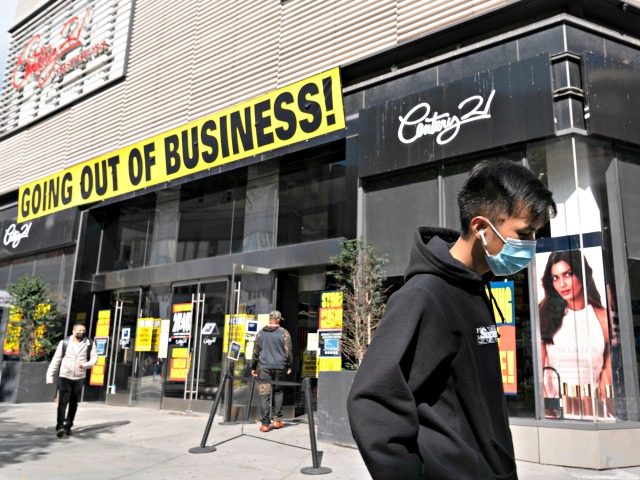US cost of living surges while wages stagnate
An unprecedented rise in prices for necessities is making it increasingly difficult for workers in the United States and internationally to make ends meet.
The cost of basic commodities such as used vehicles, food, furniture, clothes, plane tickets, recreational goods, insurance and alcohol have all risen. The surge in prices drove the US inflation rate, as measured by the Consumer Price Index (CPI), to a 13-year high of 5 percent in May, up from 4.2 percent the previous month.
The CPI jumped 0.6 percent last month, marking the fourth significant monthly increase in a row. Record prices for used vehicles, driven by a shortage of raw materials, accounted for approximately one-third of the overall increase in May. Prices climbed 7.3 percent after a 10 percent increase in April. The Manheim used car index hit 203 in May, which represents a 48.2 percent increase in used car prices over the last year.
Energy has also been a big driver of inflation, with prices soaring over 29 percent in the past year. For example, a gallon of regular gas currently costs an average of $3.10 nationwide, after the price fell under $2.00 per gallon after the pandemic hit.
Globally, housing prices have experienced the fastest growth rate since 2006, when home prices peaked amid the US housing bubble. According to the Knight Frank Global House Price Index, the average home price across 56 countries and territories rose 7.3 percent in the year to March 2021. Thirteen countries registered double-digit increases, with developing nations comprising most of the top-ten.
With a 32 percent year-over-year increase, Turkey saw the largest price increase. New Zealand and Luxembourg followed with 22.1 percent and 16.6 percent increases, respectively. The US experienced the fifth-largest increase as housing prices climbed 13.2 percent in the year to March.
Grocery prices rose by 0.4 percent in May and are expected to continue rising for some time. The United Nations Food and Agriculture Organization reported world food prices rose by 40 percent over the past year, including a rise of 4.8 percent since April. The United Nations World Food Program warned the increase in food prices is driving food insecurity, with 270 million people suffering from acute malnutrition or worse across 79 countries.
Rents in the US, which account for the single largest expense for most workers, rose 0.2 percent in May, the largest increase in over a year. Rents have gone up 1.8 percent in the last year. Economists state rent prices have risen slowly partly because of moratoriums on evictions. However, it is unclear what will happen to prices when the restrictions expire.
According to an American Association of Retired Persons (AARP) report, prescription drug prices increased at twice the US inflation rate in 2020. Although widely used brand-name prescription drugs saw their slowest annual price increase in 2020, the AARP reported the 2.9 percent increase in medication costs is still twice the country’s general inflation rate of 1.3 percent. The findings showed insurance-negotiated prices of 260 brand-name prescription drugs have increased, on average, faster than general inflation every year since 2006.
Workers are seeing their purchasing power decline at the same time essential goods are becoming more expensive.
Writing for The Hill, economic historian Dr. Tyler Goodspeed calculated real wages for US workers have declined every month in the last year, eroded by significant month-over-month increases in overall consumer prices.
The high rate of inflation completely erases the nominal increases in hourly earning within the last year. According to data provided by the United States Department of Labor, average hourly earnings rose from $29.74 to $30.33 from May 2020 to May 2021, a nominal increase of less than 2 percent. With a year-to-year inflation rate of 5 percent, this means workers have seen their real wages decline by more than 3 percent within the past year.
Last month’s jobs report and the broad surge in the cost of living indicate growing hardship among workers in the US, despite President Joe Biden’s claim that the report represented “great news” about the economic recovery from the COVID-19 pandemic.
The Labor Department reported US employers added 559,000 jobs in May, missing the 650,000 analysts predicted. May’s shortfall marked the second row in a month job gains missed expectations. Meanwhile, the unemployment rate declined 0.3 percentage points to 5.8 percent, the lowest since companies began mass layoffs in March 2020.
Even with these gains, the US economy has 7.6 million fewer workers compared to the February 2020 pre-pandemic level. So far, the US has only recovered 14.7 million, or 65 percent, of the 22.4 million jobs lost last spring.
The Biden Administration and corporate media claimed the distribution of vaccines would accelerate economic recovery, but 53,000 Americans dropped out of the labor force, ticking the participation rate down from 61.7 percent to 61.6 percent despite 48 of 50 states reopening or having completely reopened.
While everything is becoming more expensive for workers, those who own stock and other property are becoming ever wealthier.
The S&P 500 rose to an all-time high on Thursday, climbing nearly 0.5 percent to a record closing high of 4,239.18. The Dow Jones Industrial Average advanced 19.10 points, or less than 0.1 percent, to 34,466.24, while the Nasdaq Composite gained about 0.8 percent to 14,020.33.
Corporate lobbyists and the Republican Party have wailed vociferously that the federal supplemental unemployment benefits were encouraging workers to remain idle instead of taking jobs. The reality is workers are facing numerous challenges, including an ongoing pandemic which continues to sicken thousands and kill an average of 400 people every day in the US, concerns over child care and the need for higher-paying jobs. According to the Labor Department, about 4 million US workers quit their jobs in April to search for better pay.
The rapid rise in inflation will lead to an intensification of the class struggle as workers demand higher wages to ensure they can make ends meet. This is already being seen in the actions of nearly 3,000 Volvo workers in Dublin, Virginia, who have twice rejected sellout contracts pushed by the UAW and corporate management and are currently on their second strike in as many months, as well as the 1,100 coal miners on strike at Warrior Met in northwest Alabama who are demanding the restoration of wages lost over the last six years.
Worries About Big Ticket Item Inflation Hit Worse Level Since 1982

The last time Americans were this unhappy about prices of big-ticket purchases was 1982, when the Federal Reserve was fighting a war against double-digit inflation.
The University of Michigan’s survey of consumer sentiment showed U.S. consumers more concerned with higher prices of appliances, houses, and cars than anytime in 39 years, according to the survey’s chief economist Richard Curtin.
The survey records spontaneous mentions of prices of these major purchases and subtracts comments about higher prices from comments about lower prices. The difference has plummeted this year, indicating a huge imbalance in the comments due to a much larger volume of comments on higher prices.
“Spontaneous references to market prices for homes, vehicles, and household durables fell to their worst level since the all-time record in November 1974,” Curtin said. “These unfavorable perceptions of market prices reduced overall buying attitudes for vehicles and homes to their lowest point since 1982.”
Curtin said concern over prices of these categories was especially high among the top-third of earners. These consumers are responsible for more than half of retail sales.
The price of used cars rose by 7.3 percent in May, following a 10 percent gain in April. Home prices have hit record highs. Appliance prices are up 12.3 percent from a year ago, according to the most recent report on the Consumer Price Index.
Despite the worsening of this measure, overall consumer expectations moderated in the first weeks of June. The preliminary June survey showed expectations for inflation declining a bit from May, both in the one-year forecast and the five-year forecast. Even with the decline, however, expectations for the next year remain at their highest point in a decade.
Consumer sentiment improved in early June, the survey showed. The index rose to 86.4, up from 82.9 at the end of May. That was better than expected. But the gain was mostly due to increases in the experience and expectations of upper and middle income households, raising doubts about whether the Biden administration’s policies are benefiting lower-income households.
Both the current condition measure and the expectations gauge rose in early June.
“Consumer sentiment rose in early June, recouping two-thirds of May’s loss,” Curtin said. “The early June gain was mainly among middle and upper income households and for future economic prospects rather than current conditions.”
In early June, the government reported that businesses posted a record number of job openings in April, almost a million more than they had a month before. Not surprisingly, a record-high share of consumers anticipates unemployment to keep falling.
“Stronger growth in the national economy was anticipated, with an all-time record number of consumers anticipating a net decline in unemployment,” Curtin said.
Focus Group: Few Voters Believe U.S. Economy Is ‘Booming’ amid Rising Inflation

A focus group indicated Thursday only 3 of 13 voters said they felt the U.S. economy is “booming” amid rising inflation concerns.
The focus group by Engagious/Schlesinger and first reported by Axios suggested the other ten respondents “expressed fear of an impending crash following the injection of federal stimulus money during the pandemic.”
The focus group also found the following two results:
- Eight of the 13 voters said they are apprehensive about inflation in their area, citing costs going up in a number of sectors, including groceries, gas, oil and real estate.
- 10 of the 13 voters are worried about the national debt. They fear tax hikes and believe that Social Security is at stake.
The concern of inflation, which hurts the poorest Americans by making the few dollars they possess worthless in terms of purchasing power, comes as the Consumer Price Index jumped five percent in May from a year ago, the fastest rise since 2008.
The index is used to measure a basket of consumer goods and services purchased by households and is correlated with inflation.
Some economic analysts worry inflation could go on for longer than expected because of the combination of very low interest rates, pent up consumer demand for goods and services, a particularly large budget deficit, and the release of excess savings built up by stimulus payments.
To distract from the increase of price for household goods, Axios reported the White House is “more interested in touting the lowest level of jobless claims during the pandemic, with 376,000 people filing for first-time unemployment benefits last week.”
In consideration of the employment rate, some of the respondents in the focus group spoke to their decision to become employed instead of relying on government subsidies or unemployment benefits.
“It was really tempting to say ‘no,’ because I made more from unemployment than I do from my part-time job,” Kelli V. stated as respondent number one.
“I know a couple people who didn’t lose their jobs but were talking about how they wish they could. They were hoping they would get laid off (to collect unemployment),” Holly, respondent number two, said.
On May 14, Minority Leader Kevin McCarthy asked Republican governors to opt out of the federal programs in a letter to entice people back into the labor force and off the dole.
No comments:
Post a Comment